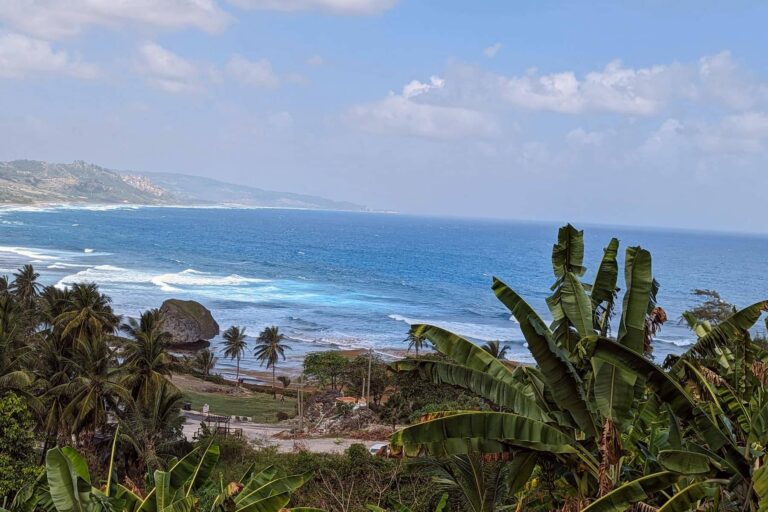
We are reader-supported and may earn a commission on purchases made through links in this article.
The western shore of the island of Barbados is lined with low, tony resorts in pastel hues, their gated entryways opening into landscaped courtyards and grand hotel entrances. The rooms face talcum-soft beaches where, just 20 feet out, the water is as clear as a vodka martini.
Here on the “Platinum Coast” of Barbados, celebrities quietly frolic in spacious villas and generously walleted British, European, and American tourists lay in for their week of paradisiacal holiday.
The East Coast of Barbados
On our recent visit to the island, we stayed on the east coast.
There wasn’t a celebrity to be seen, but from our balcony, the Atlantic was a gorgeous riot of breaking waves. As we sipped our rum in the late evening, overlooking the immense ocean shimmering beneath a nearly full moon, we’d hear a deep, powerful boom as the waves broke against high limestone outcroppings. The first time we heard it, we thought it was thunder.
This means that the east coast of Barbados offers a very different experience from the West. While this is the case in much of the Caribbean, it’s particularly true in Barbados, the region’s easternmost island by 100 miles. It’s fully exposed to an unbroken ocean expanse extending over 3,000 miles to West Africa.
Best Tips & Tools to Plan Your Trip
Habitation and settlement in the east have fluctuated over the years, but the area remains largely undeveloped. This presents some challenges for a visitor, both in finding accommodations and getting to some of the island’s attractions.
But it offers something you simply can’t find on the Platinum Coast: A powerful taste of nature, some true Bajan culture, and splendid isolation.
Things are so quiet and calm in the east some locals call it the “Medicated Coast.”
Welcome to Sam Lord’s Castle
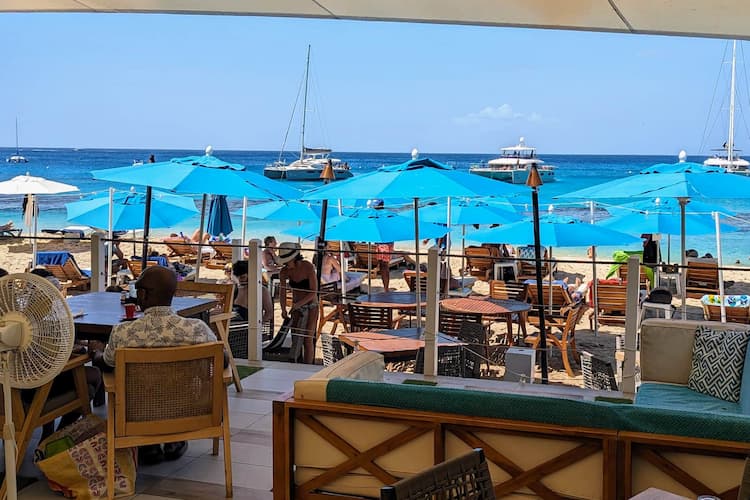
The east coast resort where we stayed, the Wyndham Grand Sam Lord’s Castle, is pretty grand indeed. Comprising a cluster of four- to five-story buildings holding 422 rooms and suites, it’s a commanding contemporary structure overlooking a stretch of beach ideal for invigorating strolls and undisturbed lounging but far too rough for swimming.
The Sam Lord has four pools, two of which are the centerpiece of the bi-level main courtyard, surrounded by cabanas and lounges. The rooms are generous, the mattresses are a joy, and the bathrooms offer marble-lined showers that, if they were in your friend’s house, you’d be jealous of.
The Wyndham is an all-inclusive, which pretty much has to be given how few restaurants, bars, and things to do are located in the east.
Dining at the Wyndham
We found the food good — though curiously its main dining venue is a Mediterranean grill, serving a typical international tourist’s menu: pasta, fish, sushi, burgers, tacos, and such, mostly well-prepared.
Still, there was abundant local fish on the menu. Service veered from friendly and efficient to unpolished. (The resort had been open less than six months when we visited, and management knew they needed to work out some staffing bugs.)
Each night’s dinner has a theme. One evening, they wheeled out a big roasted whole pig and presented head-on for a full island effect.
Another time, it was a fresh-fish-forward Bajan Night (“Bajan,” pronounced to rhyme with “Cajun,” is the locals’ preferred word for “Barbadian.”). The bars pour top-shelf drinks and decent wines at no upcharge.
The History of Sam Lord’s Castle
As for the “Sam Lord’s Castle” bit: According to legend (which is to say everything that follows should be regarded with suspicion), Sam Lord was a landbound pirate who strung lanterns in the coconut trees along the beach to lure merchant ships into what they assumed was a port. When they ran aground on coral reefs Lord’s men pounced, plundering the holds, kidnapping hapless sailors, making off with doubloons, and so forth.
Sam Lord got rich and lived in a handsome Norman-style castle. It became a hotel after passing through many hands over hundreds of years.
Its stone walls survive today as a ragged visual backdrop for the resort’s Castle View specialty restaurant and a slick marketing device. The facade of the Wyndham Grand Sam Lord’s Castle that looms above its porte cochere features calmly blinking colored lanterns.
Both the castle and the Wyndham stand today thanks to a partnership between the governments of Barbados and the People’s Republic of China. In 2010, a ruinous fire destroyed the hotel in and around the castle, and the land sat idle for several years.
Repeat visitors we met on the beach described how a few years ago hundreds of Chinese construction workers moved into temporary housing on the property and started building the resort.
The results are impressive by any national standards. The architecture offers pleasing lines inside and out, handsomely textured surfaces, and sharp finishes. The campus is comfortable and has good flow and aesthetics.
My wife and I have stayed in many resorts. Sam Lord’s Castle may be a long ride from some of Barbados’ top attractions, but its resort infrastructure ranks among the best we’ve seen.
East Meets West
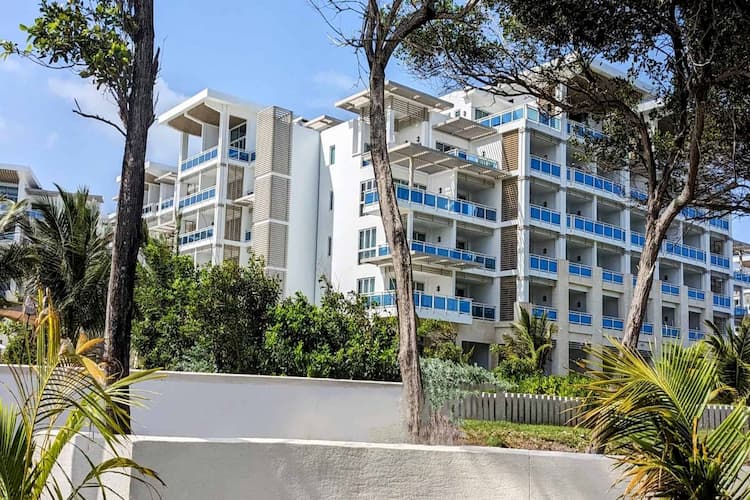
With so little to distract you, the temptation is to turn inward and enjoy the easy flow of the days on the resort. No harm in that. But there are some things to do and see from the east coast, and worthy diversions in the west. It would be a shame to miss them.
I’ve read travel guides that tell you to rent a car to get around Barbados. This is nutty. Unless you’re comfortable navigating many roundabouts while driving on the left side, managing narrow, pitted roads, and making your way through little-marked countryside byways and narrow city lanes all while surrounded by enthusiastic tailgaters, I recommend sticking with taxis.
That said, it’s expensive to cab around from the eastern side. Most things you want to do are at least half an hour away, and that’ll set you back about $30 US each way. (Though cabs are unmetered, a buck a minute held up pretty well throughout our trip.)
Take an Island Safari Tour
One day my wife and I took an Island Safari Tour, which was essentially the Bajan version of one of those sight-seeing buses that wheels you around a city to show you the highlights. We were ten visitors in a covered Jeep with a janky suspension.
Our driver narrated elaborately as we prowled along the ocean coast and its villages. Here, we’d see a few local black-bellied sheep in a backyard; there, we saw miles of sugar cane fields. Some is harvested for use by the island’s four rum distilleries, including the local pride, Mt. Gay, the oldest rummery in the world.
We saw chattel houses — simple wooden abodes built by ex-slaves, designed to be moved from one plantation to the next as the need arose. Then, we stopped at St. John’s Parish, the site of the island’s first church, in 1645; the buttressed Gothic building standing there today, replacing several antecedents destroyed by hurricanes, dates from 1836.
We passed a marker on the East Coast highway commemorating the spot where in 1966 a young Queen Elizabeth II dedicated the road. (The road connected scattered communities on the island’s east side for the first time, so it was a big deal.) Our guide took us surreptitiously into the driveway of an old plantation house, now a glorious wreck, its property operated by local farmers.
Experience Beautiful Beaches
The highlight of the trip for me was a stop at a promontory from which we looked down on Bathsheba, a surfing beach where the waves were 10 feet.
Looking across the surrounding Bajan landscape, there appeared to be a light fog.
“That’s Sahara sand,” our guide said. “Some times of year, the winds are so strong they bring sand all the way over here.”
If you were on the Platinum Coast you’d be facing away from the Sahara sands and might never notice them wafting above.
If you want a taste of the wind’s powers, the expanse of the ocean, and the connection of this beautiful little island to the rest of the world—to say nothing of some wild isolation—you need to be on the east side.
Journeys Worth Heading West For
We toured around Barbados quite a bit, and I have some recommendations. All require a taxi or car; some may be served by free resort shuttles, a service just getting started during our visit. (Absent that, the concierge can arrange taxis.) Share a ride with others and touring can be quite affordable.
St. Nicholas Abbey
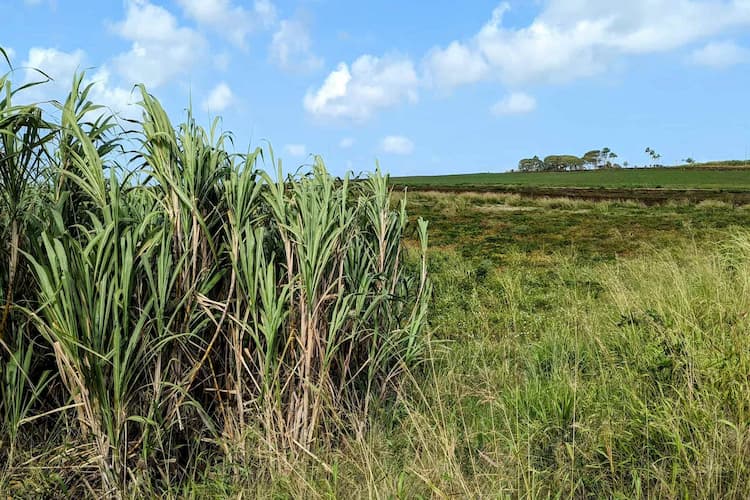
St. Nicholas Abbey, built in 1658, is the best example of an old plantation manor from Barbados’ era as a leading sugar producer. All of its owners’ wealth was created by enslaved Black workers kidnapped from Africa. This horrific history is barely noted, but the visit provides a vivid look into the lives of the 17th to 19th-century plantocracy.
There’s also a tour and tasting of its small private rum distillery and a fascinating 1930s movie that shows how cane was farmed there, by Black workers paid so little and with so few options they were almost like slaves.
You can take a ride on a restored portion of a Victorian-era narrow-gauge railway, riding in vintage cars pulled by a true steam locomotive. The railway was built to connect plantations to sugar factories but was later used by English tourists who stayed in hotels along the East Coast, a few of which survive.
Mt. Gay Rum Tour
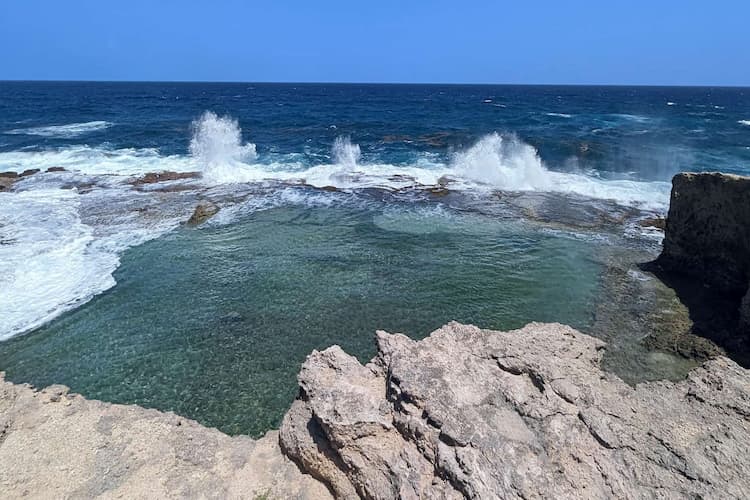
There’s a slick Mt. Gay rum visitor’s center in Bridgetown, the island’s capital city. But take the trouble to visit the factory in the countryside, the oldest continually operated rum distillery in the world, founded 1703. It’s one of the best distillery tours (and tastings) I’ve had, and provides insights into Bajan history, geography, and culture.
Oistins Fish Fry
Guidebooks will tell you to go to the Fish Fry on Friday nights, when locals and tourists mingle in a lively crowd, enjoying fish fresh right off the boats. Well, sure. But fair warning: The stage show is staggeringly loud and the scene uncomfortably packed.
After finding a seat at a picnic table across from a lovely local lady we were unable to talk to her at all due to the thumping music. I could feel the beat in the fluid around my kneecaps.
If this doesn’t sound like your jam, go any other day of the week for fresh-off-the-boat, hot-off-the-grill flying fish and snapper, with local favorite sides like cou cou, macaroni pie, sweet potatoes, plantains, breadfruit, and hot cakes. If you want a taste of what Bajans eat, the food at Oistins is not to be missed.
Payne’s Bay Beach
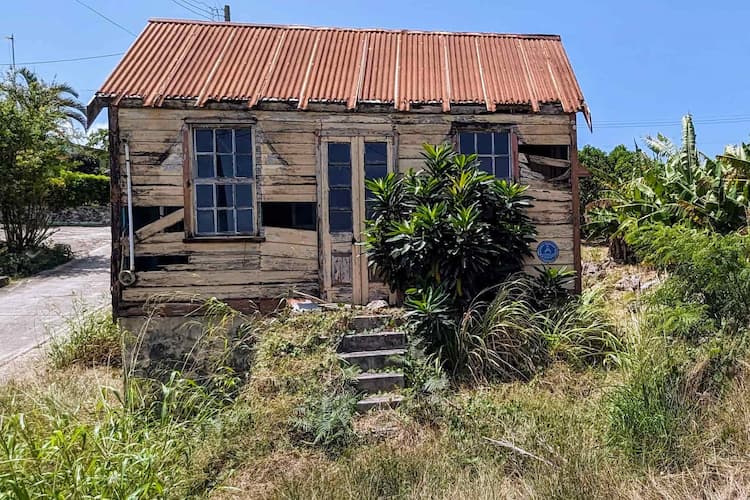
Want a touch of the Platinum Coast vibe? Taxi to Payne’s Bay beach (all beaches in Barbados are public). You’ll get a taste of the turquoise waters and pristine sand experienced by folks who stay on the west coast.
You can rent lounges and umbrellas; refreshments and showers are available. Rent snorkeling gear and you may see turtles.
Eating in Barbados
We ate at several good restaurants, looking for those that serve up local specialties. At the award-winning Cocktail Kitchen, I had meltingly rich Bajan black-bellied lamb over risotto and a perfectly pinked, locally farmed pork chop.
At Calma Beach Club, on a stretch of west coast beach, I experienced pig tails, a Bajan favorite. Yes, I’m talking about the tails of pigs. Eat around the fat and the meat is luscious.
We ran the table of local fish during our visit, trying among others just-off-the-boat versions of flying fish (don’t miss it; it’s crisp and light and almost creamy in texture), snapper, mahi-mahi, and Barracuda (fishier and, to me, the least desirable of the bunch).
I had spectacular king fish ceviche at Local & Co.; it was topped with slices of aloe. The Flying Fish Duo at the Fish Pot included a delightful “pate” (a patty of fish paste with cream cheese and spices) with lightly fried strips of the fish laid on top. The curried off-the-boat mahi-mahi there was also great.
The Caribbean lobster was excellent at Wyndham Grand’s Castle View restaurant and a couple other places. Note that Caribbean lobsters have no claws, and the meat is generally firmer than you’ve come to expect from the Maine variety. But you didn’t come to Barbados for American food, did you?
For information, visit the official Barbados tourism website.
Read More:
Author Bio: Former travel editor of the Washington Post, Craig Stoltz is a freelance writer whose work has recently appeared in Fodor’s, Frommer’s, Garden & Gun, and Food, Wine & Travel Magazine.

